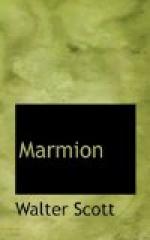line 141. for that = ‘because,’ a common Elizabethan connective.
line 165. ’"Come then, my friend, my genius,
come along,
Oh
master of the poet and the song!”
Pope
to Bolingbroke.’—Lockhart.
Cp. also the famous ‘guide, philosopher, and
friend,’ in ’Essay on
Man,’ iv. 390.
lines 166-175. For a curious and characteristic ballad by Leyden on Ellis, see ‘Life of Scott’ i. 368; and for references to his state of ealth see ‘Life,’ ii, 17, in one of Scott’s letters.
line 181. ’At Sunning-hill, Mr. Ellis’s seat, near Windsor, part of the first two cantos of Marmion were written.’—Lockhart. Ascot Heath is about six miles off.
Canto fifth.
Stanza I. line 18. ’This is no poetical exaggeration. In some of the counties of England, distinguished for archery, shafts of this extraordinary length were actually used. Thus, at the battle of Blackheath, between the troops of Henry vii and the Cornish insurgents, in 1496, the bridge of Dartford was defended by a picked band of archers from the rebel army, “whose arrows,” says Holinshed, “were in length a full cloth yard.” The Scottish, according to Ascham, had a proverb, that every English archer carried under his belt twenty-four Scots, in allusion to his bundle of unerring shafts.’—Scott.
Stanza ii. line 32. croupe = (1) the buttocks of the horse, as in Chaucer’s ‘Fryars Tale,’ line 7141, ’thakketh his horse upon the croupe’; (2) the place behind the saddle, as here and in ’Young Lochinvar,’ below, 351.
line 33. ’The most useful air, as the Frenchmen term it, is TERRITERR, the courbettes, cabrioles, or un pas et un sault, being fitter for horses of parade and triumph than for soldiers: yet I cannot deny but a demivolte with courbettes, so that they be not too high, may be useful in a fight or meslee; for, as Labroue hath it, in his Book of Horsemanship, Monsieur de Montmorency having a horse that was excellent in performing the demivolte, did, with his sword, strike down two adversaries from their horses in a tourney, where divers of the prime gallants of France did meet; for, taking his time, when the horse was in the height of his courbette, and discharging a blow then, his sword fell with such weight and force upon the two cavaliers, one after another, that he struck them from their horses to the ground.’—Lord Herbert of Cherbury’s Life, p. 48.—Scott.
line 35. ’The Scottish burgesses were, like yeomen, appointed to be armed with bows and sheaves, sword, buckler, knife, spear, or a good axe instead of a bow, if worth L100: their armour to be of white or bright harness. They wore white hats, i.e. bright steel caps, without crest or visor. By an act of James iv their weapon-schawings are appointed to be held four times a year, under the aldermen or bailiffs.’—Scott.




